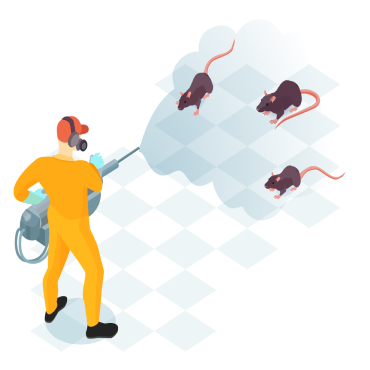Expert Rodents Management
Rodents Management
Rodents are mammals of the order Rodentia, which are characterized by a single pair of continuously growing incisors (teeths) in each of the upper and lower jaws. About 40% of all mammal species are rodents.Rodents are extremely diverse in their ecology and lifestyles and can be found in almost every terrestrial habitat, including human-made environments.Most rodents are herbivorous, feeding exclusively on plant material such as seeds, stems, leaves, flowers, and roots. Some are omnivorous and a few are predators. The standard life expectancy of mice and rats is about one year. However, indoor rodents can live for 2 to 3 years. Without harsh environments or predators such as owls, cats, or hawks, rodents can be expected to live longer.
Mice and rats that live indoors with adequate food, water and shelter can have increased capacity to breed all year long.


Why are they considered as Pests
The major Rodents which are matter of concern are Rats, mice, Roof Rats & Bandicoots, norvay rat . As per the CDC data, Worldwide, rats and mice spread over 35 diseases. These diseases can be spread to humans directly, through handling of rodents, through contact with rodent feces, urine, or saliva, or through rodent bites. Diseases carried by rodents can also be spread to humans indirectly, through ticks, mites or fleas that have fed on an infected rodent.
Rodents can spread many diseases like:
1. Hantavirus pulmonary syndrome
2. Leptospirosis
3. Plague
4. Rat-bite fever
5. Salmonellosis
6. Tularemia
Apart from diseases Rats and mice have also been responsible for major damage to store supplies, home furnishings, and even buildings. With their ability to crawl through pipes and slip into hard-to-reach areas, rodents come into contact with sensitive circuitry that connects to power grids in towns and cities everywhere. Using their sharp incisors, the critters gnaw at electrical wires and insulation materials, causing short circuits and sparking fires in the process.
Sign of Rodent Infestation
 Rodent droppings around food packages, in drawers or cupboards, and under the sink.
Rodent droppings around food packages, in drawers or cupboards, and under the sink. Nesting material such as shredded paper, fabric, or dried plant matter.
Nesting material such as shredded paper, fabric, or dried plant matter. Signs of chewing on food packaging.
Signs of chewing on food packaging. Holes chewed through walls and floors that create entry points into the home.
Holes chewed through walls and floors that create entry points into the home. Stale smells coming from hidden areas, Greece mark on cables and pipelines and in entry points.
Stale smells coming from hidden areas, Greece mark on cables and pipelines and in entry points.
How to we Prevent them
The best way to prevent a rodent infestation and contact with rodents is to remove the food sources, water, and items that provide shelter for rodents. Major rodent entry points needs to be identified and sealed. External area of the facility should be kept clean of debries and garbage pile up.
Unwanted plants and weeds should be cleaned on regular basis so that rats get minimum opportunity to hide and make burrows.
Treatment Options
Rodents are very clever in nature and once an infestation gets established it becomes a tough task to manage the same. There are several DIY Options available in market like repellents , traps, cages etc however, to have a desired control its always advisable to get the treatment done form a professional PCO. Key to Rodents management is to maintain three line of defense protecting common areas, external periphery and internal areas of the targeted facility.
Considering the various types of rodents and behavior, multiple control methods are used best suited for the targeted areas. Poison baits are used only in external areas directly into burrows or in tamper proof rodent bait stations ensuring effective results without compromising safety.
Infestation within internal areas of premises is managed by trapping with high-quality sticky traps and other mechanical catching devices.
Benifits of Choosing Us
The advanced methodology used to ensure most effective results.We understand rodent behavior more than anyone else. Hence, treatment types are modified from time to time based on their activity analysis.Expert audits and support help our customers to plug the entry point which minimizes chances of future infestation.
Effective rodent management not only protects our customer health but also safeguard the targeted facility from rodent triggered economical damage.
